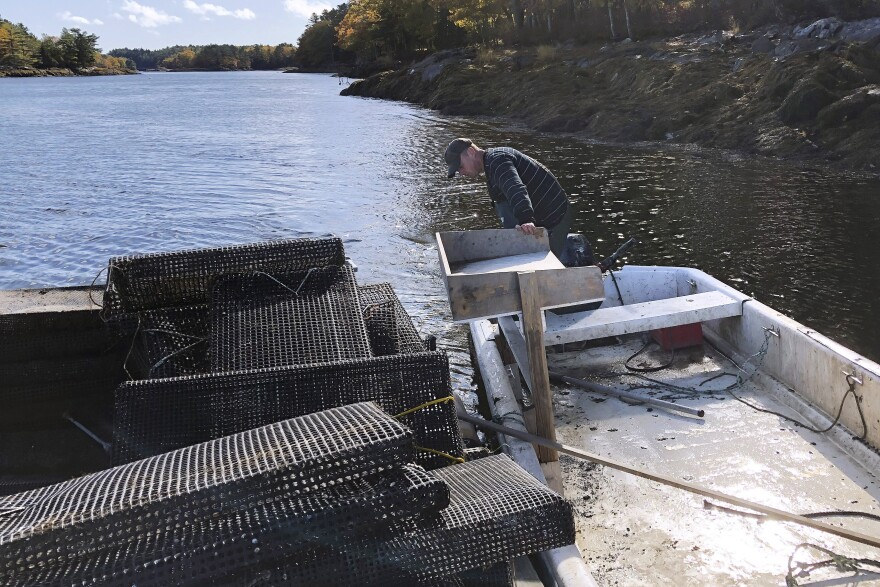In the last 8 years, Maine’s aquaculture harvest has more than doubled in volume and in value, and some predict that the state's aquaculture exports could be worth as much as $800 million by 2025. A new report is recommending how that growth should be managed over the next decade. But critics say it's too focused on expanding the industry, and gives short shift to other users of the ocean commons or the ecosystems that they all depend on.
The document sets broad goals for aquaculture's next decade in Maine, starting with streamlined permitting for public water leases that "balances the rights of the applicant and the public.
And it identifies the potential costs of specific actions: $100,000, for instance, to support a state employee who would help applicants get through the permitting process and engage with host communities, $100,000 to integrate aquaculture into K-12 education, and a quarter million dollars to create a Maine Seafood Council to market both farmed and wild-caught seafood.
"It's one tool that can be used along with the many tools the state has in thinking about the future," said Gayle Zydlewski, who directs Maine Sea Grant, a federal-state program housed at the University of Maine that led a collaborative effort to create the so-called Maine Aquaculture Roadmap.
"There is definitely a lot happening in this space. And the roadmap is meant to help the sector strengthen opportunities to connect with local coastal communities. So it really is a time to be thinking about our working waterfront (and) aquaculture and fisheries, recreation and tourism," Zydlewski said.
More than 140 stakeholders weighed in, including Chebeague Island oyster farmer Bob Earnest, who sees the plan as a useful guide for growing the industry in a sustainable way.
"We don't want the government managing how many oysters we produce. (They would not be efficient at that.) But we also don't want every retired person like me in the state of Maine selling unsafe product because we're issuing too many licenses and not doing enough education. It's not an easy proposition. This road map speaks to all the right aspects of that evolving industry," Earnest said.
He added, though, that the sustainability of small, independent farms could be challenged by an emerging influx of venture capital that's backing industrial-scale shellfish farming, and proposed finfish farms on and off the coast.
And there are sharper critics.
"The lack of even mentioning any sort of tradeoff of aquaculture in any of these conversations is hugely concerning," said Marissa McMahan, a Georgetown-based marine scientist who participated in one of the stakeholder focus groups. She's also one of 19 people who signed a recent letter to Sea Grant criticizing the road for overlooking the value of shared waters for many outside of the aquaculture industry.
"There's no mention of the tradeoffs, and there are potential environmental impacts. There are huge potential social impacts. It's all linked," McMahan said.
Other critics who signed the letter include lobstermen, the director of Stonington's Maine Center for Coastal Fisheries, several UMaine researchers and Downeast Salmon Federation Director Dwayne Shaw. He said the road map fails to provide a plan for assessing the cumulative impacts of aquaculture leases on ecosystems and wild fisheries, and how aquaculture can hurt efforts to restore them.
"Its not a comprehensive plan but more of a bit of advocacy for economic development utilizing aquaculture. And because aquaculture is so complex with various types of farms being proposed, it's very important that we move cautiously," Shaw said.
But supporters maintain that fears about unbound growth are unfounded. Brianna Warner is the CEO of Atlantic Sea Farms, the state's biggest seaweed processing company, which provides free seed to 27 independent lobstermen who spend their off-seasons growing and harvesting seaweed.
"We have this thing in Maine which I find very interesting that puts value judgments around 'big is bad and small is good,'" Warner said.
Warner said the state's leasing application process is vigorous and protective of users and the environment. If Maine really wants to create more jobs on the water, she added — good-paying jobs with benefits — some aquaculture operations are going to need to get big enough to achieve the revenue streams that make that possible.
"Look, I think the industry needs to grow responsibly but I don't think there's any indication that it's not," she said.
The road map authors plan another look at the issues in 2026. And in the meantime Sea Grant director Gayle Zydlewski said she is seeking further conversations with the plan's critics, and a broad multi-sector seafood planning effort, Sea Maine, is getting under way as well.


